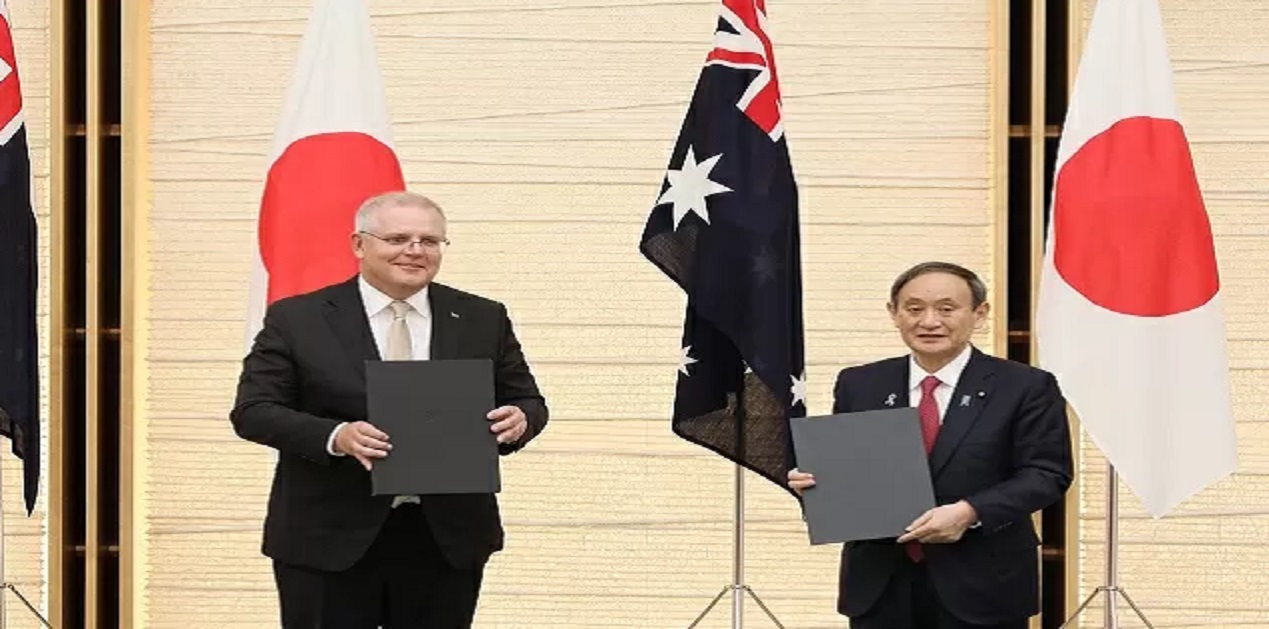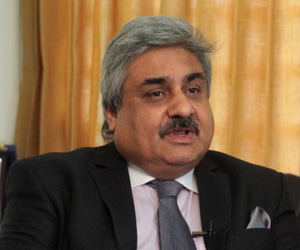Australia and Japan signed a new defence agreement on 6 January 2022, which both PM Scott Morrison and PM Fumio Kishida hailed as a landmark. The Reciprocal Access Agreement (RAA) is Japan’s second such Agreement with any country, after treaty ally US, and in essence, will allow Australian and Japanese armed forces access to each other’s territories through deployments, and to work seamlessly with each other on defence, joint training and humanitarian operations by easing restrictions on the transport of weapons and supplies. The Agreement has been some years in the making, and is being seen as a move away from the US centric outlook towards a greater focus on bilateral relations and regional groupings especially for Japan. Analysts in Japan and Australia see this Agreement as the beginning of a new security structure independent of the United States, which could eventually bring in additional allies, both Asian and European – and the Agreement has specific provisions in that regard. The 2+2 talks involving Australian and Japanese foreign and Defence Ministers started in 2010, and the RAA is one of the prominent outcomes from nine rounds of those discussions. Australia and Japan have already signed the 2010 Acquisition and Cross Servicing Agreement, and the 2012 Information Security Agreement. They also signed, in 2014, an Agreement on Transfers of Defence Equipment and Technology, a necessity for exports and joint development. In a sense cooperation envisioned under the RAA had already started earlier in practical terms – in November, Japanese destroyer escorted an Australian ship through waters off Shikoku, marking the first time the Japanese Self-defense Forces had protected a non-US military asset. A few months earlier the two countries had agreed to allow their air forces to refuel each other’s aircraft midflight.
Australia and Japan are both Pacific powers; have a strong economic relationship which blossomed after the military confrontation during World War II. They share common concerns like security of their sea lanes, pressure on them by a belligerent China and a complicated and increasingly unreliable alliance with the United States, which itself is under pressure domestically.
Australia and Japan signed the Basic Treaty of Friendship and Cooperation in June 1976, and their relationship, especially in trade and investments, has blossomed since then. Australia is now Japan’s fourth largest, and Japan Australia’s second largest trading partner. Australia is the leading supplier of energy and mineral resources to Japan. The two countries signed the Australia Japan Declaration on Security Cooperation in 2007, and the Australia Japan Economic Partnership Agreement (EPA) in 2015. They worked together for the Comprehensive and Progressive Agreement for Trans Pacific Partnership (CPPTP) when President Trump pulled the US away from the Trans Pacific Partnership talks in 2016. By 2018, Australian commentators and strategic thinkers were arguing that while Australia’s defence relationship with the US could continue, Australia had to increase defence spending, consider security ties with Japan, develop nuclear submarines and bolster its armed forces.
The Japanese Ministry of Economy, Trade and Industry has been working on beefing up the legal framework for transfer of military equipment and technology to Australia since 2014. The RAA simplifies entry procedures for each country’s forces, and clarifies their legal status, including the laws which apply under specific circumstances. Japan maintains the death penalty, while Australia has abolished it, and this was one of the main sticking points during the negotiations. The Japanese level of participation in the Talisman Sabre Joint Exercises in Australia has gone up sharply in terms of assets, equipment as well as personnel. The RAA will facilitate “cooperative activities such as joint exercises and disaster relief operations, including those of greater scale and complexity” between Australia’s military and Japan’s Self-Defense Forces. Australia’s armed forces, at 60,000, are smaller than Japan’s 220,000 strong Self Defense Forces, but Japan has expressed interest in learning from the Australian experience in the US led invasion of Iraq. Japan has also allowed its Amphibious Rapid Deployment Brigade, a Ground Self Defense Force Unit which has been raised specifically with the aim of defending isolated islands, to join Australian and US and UK marine troops last year for a large-scale exercise which was hosted by Australia. It is significant that they rehearsed manoeuvers to fend off an invasion.
Japan has a Status of Forces Agreement with the US which was signed in the 1960s allowing the US to base warships, fighter jets and troops in and around Japan. The doubts about US reliability came to surface during the Trump Presidency, following Trump’s musings about ending the security pact with Japan, and his visit to the North Korean side of the Demilitarized Zoneas well as embrace of its leader Kim Jong Un. While these doubts have been allayed to a large extent during the Biden Presidency, the wheels for the Reciprocal Access Agreement had already been set in motion, and the Agreement provides for a future Pan Asian, Indo Pacific Security structure that would include Western Europe. While both countries are keen to maintain their defense and security alliance with the United States; the RAA, along with the Quad and the AUKUS pacts, is seen as an alternate means to guarantee their security in the Pacific in the light of an aggressive and belligerent China which both view as destabilizing.
To a large extent, the RAA has been enabled, among other factors, by Australia’s willingness to stand up to China on the question of a free and open Indo – Pacific and rules based global order, despite their deep economic ties. Australia has increased engagement with Indo Pacific partners, participating in the Quad defense framework with Japan, the US and India and the new AUKUS defense pact with the US and UK. For Japan, this marks an even greater shift and that is in keeping with the recent evolution of its outlook and global image. Japan has pursued deeper security relationships with UK, India, France and Germany, to deal with China’s military heft, which is now at its doorstep. In case of a Chinese invasion of Taiwan, Japan’s Nansei islands would lie in the battle theater. Japan and Australia, in this case, will need to present a united stand. Japan’s defence cooperation with Vietnam and Philippines has recently signalled its desire to play a grater regional and strategic role. Japan is likely to seek similar RAA - like agreements with UK with whom these talks have already started, and France who are also seen as important players in the Indo Pacific.
Concerns over China clearly came out in a statement issued by PM Kishida and Scott Morrison after their virtual meeting when they expressed opposition to “any destabilizing or coercive unilateral actions that seek to alter the status quo and increase tensions in the East China Sea”, where China has pressurized Japan through incursions of increasing regularity. They also stressed the importance of peace and stability across the Taiwan Straits, and expressed concern on human rights abuses in Xinjiang. At the signing ceremony, Australian PM Scott Morrison said ‘Japan is our closest partner in Asia as demonstrated by our special strategic partnership, Australia’s only such partnership – an equal partnership of shared trust between two great democracies committed to the rule of law, human rights, free trade and a free and open Indo–Pacific”. PM Kishida hailed the agreement as “a landmark instrument which will elevate security cooperation between the nations to new heights”. Japan’s Ambassador to Australia, Shingo Yamagami, said that “in light of the deteriorating security environment, what Japan and Australia can do together is first of all to increase deterrence”. The Chinese response was on expected lines when it said that “bilateral treaties should promote regional trust, peace and stability and should not target or harm any third-party interests”. The Chinese spokesperson also said that “The Pacific Ocean is big enough for the common development of countries in the region. Along the same line, peace and stability in the Pacific depends on the joint efforts of countries in the region. We hope that the Pacific will be an ocean of peace, not a place to make waves”. This reaction is in contrast to Chinese Foreign Minister Wang Yi’s dismissive tone in relation to the Quad when he said that the grouping “will dissipate like sea foam”.
In so far as India as concerned, the moves to sign reciprocal logistic agreements with the US, Australia and Japan, its 2+2 dialogues with the US, Japan and Australia and Russia, and its participation in the Quad have been timely. In response to aggressive Chinese moves to seize control of critical infrastructure in the in the Indo Pacific, Japan, US and Australia are planning to fund 5 G telecom networks in the South Pacific, and Japan, Australia and India have launched a framework to mutually strengthen their supply chains in order to rely less on China. Besides the Malabar Exercises with the other Quad countries, India is participating with the navies of Australia, Canada, Japan, US and South Korea in the anti-submarine Sea Dragon Exercises in the Pacific Ocean. Japan will soon host the next Summit meeting of the Quad in March 2022 where the agenda for countering China in its attempts to control critical technologies and rare earths will be further fleshed out. The G-7 initiatives like “Blue Dot”, “Build Back Better (B3W), and the European Union’s “Global Gateway” initiative are all attempts to counter China’s Belt and Road Initiative which often uses opaque methods for financing projects and results in indebtedness in partner countries. These developments will enable India to become part of the evolving security architecture for a rules-based order and freedom of navigation in the region, and act as a deterrent for future unbridled and aggressive Chinese expansion into the Indian Ocean.
(The paper is the author’s individual scholastic articulation. The author certifies that the article/paper is original in content, unpublished and it has not been submitted for publication/web upload elsewhere, and that the facts and figures quoted are duly referenced, as needed, and are believed to be correct). (The paper does not necessarily represent the organisational stance... More >>
Image Source: https://img.jagranjosh.com/imported/images/E/GK/japan_australia_sign_landmark_defence_deal.webp










Post new comment